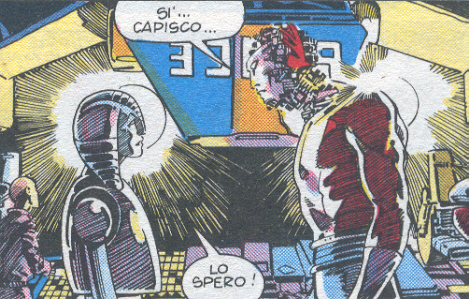
Image: Machine Man from the cover
of the TPB, art by Barry Windsor Smith, Copyright (1984) Marvel Comics
|
|

Image: Machine Man from the cover
of the TPB, art by Barry Windsor Smith, Copyright (1984) Marvel Comics
Here is a machine that would certainly pass Turing's test
for intelligence :-)
As the introduction of the Italian
edition points out, in american adventure
and super-hero comics, a robot can be a great enemy, an unstoppable killer,
but rarely becomes a protagonist or a hero. A robot does not have the necessary
qualities: A robot cannot die, or love, or have a moral sense.Yet, Machine
Man is a protagonist, a hero. Created by Jack "The King" Kirby, Machine
Man appeared for the first time in 1977 in the 8-th issue of "2001: a space
odissey". Later he gained his own series, whose authors were again Jack
Kirby and later on Steve Ditko. This series lasted 19 issues. And then,
after several years of absence, Machine Man returned. He returned with
his slightly caustic humor, with his icy reservedness, with his tepidly
stainless feelings. With his being indeed a protagonist, a hero.
Here, I am considering the four-issues mini-series of 1984-85, republished as paperback in 1988. This was written by Tom De Falco, and pencilled both by Herb Trimpe and Barry Windsor Smith, who took care also of inking and colouring.
The story takes place in 2020 AD, i.e. 35 years in the future (with respect to the time the story was written). The story narrates of how, during a day in 2020, a box containg Machine Man's disassembled body is discarded through an automatic procedure from a warehouse of Bain industries. Sunset Bain is an old villain of the Marvel universe, involved in weapons traffic and electronic industries. She appeared recently in some issues of Iron Man. Back to the future, 2020 AD: Sunset is seventy years old and is now head of an industry of electronics and robotics that she runs without scruples.
Against an humanity mesmerized by the media and by Bain industires with the help of technology (of which the "vidiots" are only one example), an organization of young "predators" keeps a fight against the system. One little group of predators finds the discarded box and, out of curiosity, reassembles and reactivates Machine Man.


Machine Man finds himself disoriented from being in the future, and is immediately involved in a fight against a deadly C-28 robot Bain industries have sent to stop the predators. Machine Man follows the group that has just reactivated him and finds that the leader of the group is an old friend of his, Gears Garvin (a co-protagonist of the older Machine Man series). Sunset Bain hires the corrupted Iron Man of 2020 to eliminate both MM and the predators, but Iron Man fails and Machine Man proves eventually to be more human than him.

Upon finally defeating Sunset Bain and after the suicide of another old enemy of his, the corrupted senator Miles Brickman, Machine Man meets his old love, the artificial being Jocasta, another robot (related also to Ultron and the Avengers). Jocasta has been attending Sunset Bain for years and feels now old, preferring not to join MM in his new life, while still caring for him. MM leaves with his friends predators leading eastward... "why eastward?".... "Why not?"


The magic in this mini-series comes from seeing a sentient
artificial being "wake up" after some 35 years and finding out several
friends are now dead, a world that has improved and worsened at the same
time... can he make it in this new world? Are some of his friends still
alive? Does anyone care after all this time ? Does he have the energy and
the will power to start again anew? Can he rely on his newfound allies?
Machine Man has a lot of doubts. How much of our life is circumstantial
and how much comes from a core that is independent of circumstances? What
would you do if you woke up among strangers tomorrow, thirty five years
in the future? Can love resist 35 years? And all these questions concern
a robot, not a natural human being... Of course many of these situations
are classic in science fiction, but they somehow suit well Machine Man.
The mini finds further interest in Barry Windsor Smith's art. His passion
for the machines is quite evident, and his use of colours quite interesting.
Also, the cover for the paperback edition is now a classic.
